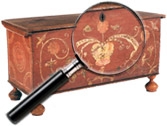|
|
Staddle Stones
Staddle stones take their name from the Old English stathol which means a support or the trunk of a tree. These nifty little pedestals that seem to defy the laws of physics have been used for hundreds of years as the elevating bases for granaries, beehives, game larders, hayricks, and even small barns – any outbuilding that might warehouse things prone to attracting pests. Staddle stones occasionally appear in other places, but [...] Click here to continue reading.
Estate of Peter L. Rosenberg of Vallin Galleries, Wilton Connecticut
Discerning collectors, dealers, and museum curators of Asian art regularly made pilgrimages to a charming 18th century saltbox home in Wilton, Connecticut: Vallin Galleries. Owned and operated by Peter L. Rosenberg for nearly thirty years until his sudden death in December of 2013, Vallin Galleries was widely regarded as an outstanding source for the best of Asian art and antiques. Skinner is proud to [...] Click here to continue reading.
The Sarcophagus in Decorative Arts
Derived from the Greek sarx, meaning flesh, and phagein, meaning eat, a sarcophagus is, essentially, a container for a body, much like a coffin or casket. Historically, sarcophagi were typically made of stone (though sometimes of other materials, such as wood or metal), with a relief-carved or pediment top, and designed to be above ground, and have been used by many cultures since ancient times.
An ancient [...] Click here to continue reading.
Vermeil
“Vermeil” is a French word co-opted by the English in the 19th century for a silver gilt process. Vermeil is a combination of silver and gold, although other precious metals are also occasionally added, that is then gilded onto a sterling silver object. The reddish (vermilion) hue of the addition of the gold gives the product its name. Vermeil is commonly found in jewelry, and a standard of quality (10 karat gold) and [...] Click here to continue reading.
Tagua Nuts
Tagua nuts are the endosperm of a genus of South American palm trees that are found from Panama down through Bolivia and Peru. Tagua nuts, or more accurately, the kernels of tagua seeds, are left behind by the wildlife that feed on the palm’s fruit. The group of palms is often referred to as “tagua palms” or “ivory-nut palms,” because tagua nuts are so hard, they resemble elephant ivory. (In fact, the [...] Click here to continue reading.
Baleen, Plastic of the 18th Century
Baleen comes from a suborder of whales, Mysticeti, which includes, among others, humpback whales, gray whales, right whales and blue whales. What sets these whales apart is baleen. These whales do not have teeth, but have upper jaws filled with two rows of baleen plates fringed with fine baleen hair. These plates are so closely aligned that they act like a comb or a sieve; whales pull water [...] Click here to continue reading.
Bakelite
Scandal & the Story of Bakelite Bakelite hit the market in 1907, heralding the arrival of the modern plastics industry. Bakelite was the first completely man made plastic, as until then, plastics such as celluloid, casein, and Gutta-Percha all had as a base a natural material. It was developed by Belgian-born chemist Dr. Leo Hendrick Baekeland who started his firm General Bakelite Company to produce the phenolic resin type plastic. Bakelite was inexpensive [...] Click here to continue reading.
Ormolu
Ormolu, an 18th-century English term, is from the French phrase or moulu, with “or” indicating gold and “moulu” being a form of an old French verb moudre, which means “to grind up.” (This French term for this technique is bronze dore.) This idea of “ground-up gold”refers to the production process of ormolu, where high-quality gold is finely powdered and added to a mercury mixture and applied to a bronze object. Modern usage often [...] Click here to continue reading.
Chrome by Chase- The Art Deco Years
The Art Deco style may have originated in Europe, but Americans embraced it for everything from skyscrapers to soap dishes, and nobody did it better than Chase.
First Waterbury, then Chase Art Deco buildings like the Chrysler Building and Radio City Music Hall in New York, the Union Terminal in Cincinnati, and much of Miami Beach needed lighting and accessories to go with this exciting new [...] Click here to continue reading.
The Collection of Mr. and Mrs. James Grievo, Stockon, New Jersey
It all started around 1971. Just home from college and having a difficult time finding a job, I started going to house tag sales where I would find small interesting things to sell to antique dealers. It was something I really enjoyed doing, and 1 was amazed I was making real money for the first time. I soon realized that this was [...] Click here to continue reading.
|
Recent Articles
- Charles Alfred Meurer – American Artist & Tromp L’Oeil Artist
- Sendak, Maurice – American Artist & Writer
- Godie, Lee – American Artist
- Davis, Vestie – American Artist
- Bartlett, Morton – American Artist
- Mackintosh, Dwight – American Artist
- Evans, Minnie Jones – African-American Artist
- Mumma, Ed (Mr. Eddy) – American Artist
- Nice, Don – American Artist
- Savitsky, John (Jack) – American Artist
- Gordon, Harold Theodore (Ted) – American Artist
- Dial, Thornton – African-American Artist
- Doyle Sam – American Artist
- Johnson, Lester Frederick – American Artist
- Finster, Howard – American Artist
|
|
